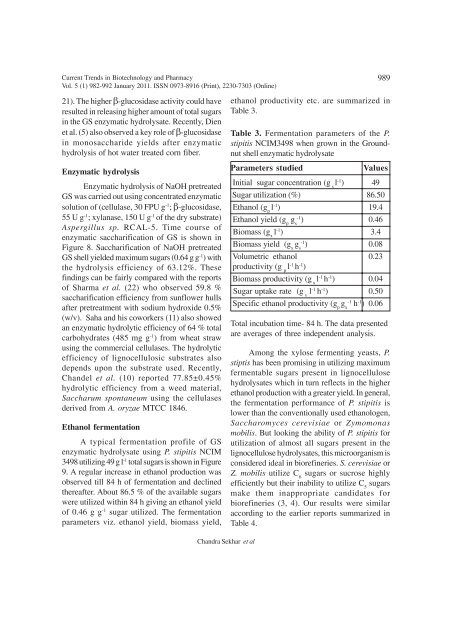full issue - Association of Biotechnology and Pharmacy
full issue - Association of Biotechnology and Pharmacy
full issue - Association of Biotechnology and Pharmacy
- No tags were found...
Create successful ePaper yourself
Turn your PDF publications into a flip-book with our unique Google optimized e-Paper software.
Current Trends in <strong>Biotechnology</strong> <strong>and</strong> <strong>Pharmacy</strong>Vol. 5 (1) 982-992 January 2011. ISSN 0973-8916 (Print), 2230-7303 (Online)98921). The higher β-glucosidase activity could haveresulted in releasing higher amount <strong>of</strong> total sugarsin the GS enzymatic hydrolysate. Recently, Dienet al. (5) also observed a key role <strong>of</strong> β-glucosidasein monosaccharide yields after enzymatichydrolysis <strong>of</strong> hot water treated corn fiber.Enzymatic hydrolysisEnzymatic hydrolysis <strong>of</strong> NaOH pretreatedGS was carried out using concentrated enzymaticsolution <strong>of</strong> (cellulase, 30 FPU g -1 ; β-glucosidase,55 U g -1 ; xylanase, 150 U g -1 <strong>of</strong> the dry substrate)Aspergillus sp. RCAL-5. Time course <strong>of</strong>enzymatic saccharification <strong>of</strong> GS is shown inFigure 8. Saccharification <strong>of</strong> NaOH pretreatedGS shell yielded maximum sugars (0.64 g g -1 ) withthe hydrolysis efficiency <strong>of</strong> 63.12%. Thesefindings can be fairly compared with the reports<strong>of</strong> Sharma et al. (22) who observed 59.8 %saccharification efficiency from sunflower hullsafter pretreatment with sodium hydroxide 0.5%(w/v). Saha <strong>and</strong> his coworkers (11) also showedan enzymatic hydrolytic efficiency <strong>of</strong> 64 % totalcarbohydrates (485 mg g -1 ) from wheat strawusing the commercial cellulases. The hydrolyticefficiency <strong>of</strong> lignocellulosic substrates alsodepends upon the substrate used. Recently,Ch<strong>and</strong>el et al. (10) reported 77.85±0.45%hydrolytic efficiency from a weed material,Saccharum spontaneum using the cellulasesderived from A. oryzae MTCC 1846.Ethanol fermentationA typical fermentation pr<strong>of</strong>ile <strong>of</strong> GSenzymatic hydrolysate using P. stipitis NCIM3498 utilizing 49 g l -1 total sugars is shown in Figure9. A regular increase in ethanol production wasobserved till 84 h <strong>of</strong> fermentation <strong>and</strong> declinedthereafter. About 86.5 % <strong>of</strong> the available sugarswere utilized within 84 h giving an ethanol yield<strong>of</strong> 0.46 g g -1 sugar utilized. The fermentationparameters viz. ethanol yield, biomass yield,ethanol productivity etc. are summarized inTable 3.Table 3. Fermentation parameters <strong>of</strong> the P.stipitis NCIM3498 when grown in the Groundnutshell enzymatic hydrolysateParameters studiedValuesInitial sugar concentration (gs l-1 ) 49Sugar utilization (%) 86.50Ethanol (g pl -1 ) 19.4-1Ethanol yield (g pg s) 0.46Biomass (g xl -1 ) 3.4-1Biomass yield (g xg s) 0.08Volumetric ethanol 0.23productivity (g pl -1 h -1 )Biomass productivity (gx l-1 h -1 ) 0.04Sugar uptake rate (gs l-1 h -1 ) 0.50-1Specific ethanol productivity (g pg xh -1 ) 0.06Total incubation time- 84 h. The data presentedare averages <strong>of</strong> three independent analysis.Among the xylose fermenting yeasts, P.stiptis has been promising in utilizing maximumfermentable sugars present in lignocellulosehydrolysates which in turn reflects in the higherethanol production with a greater yield. In general,the fermentation performance <strong>of</strong> P. stipitis islower than the conventionally used ethanologen,Saccharomyces cerevisiae or Zymomonasmobilis. But looking the ability <strong>of</strong> P. stipitis forutilization <strong>of</strong> almost all sugars present in thelignocellulose hydrolysates, this microorganism isconsidered ideal in biorefineries. S. cerevisiae orZ. mobilis utilize C 6sugars or sucrose highlyefficiently but their inability to utilize C 5sugarsmake them inappropriate c<strong>and</strong>idates forbiorefineries (3, 4). Our results were similaraccording to the earlier reports summarized inTable 4.Ch<strong>and</strong>ra Sekhar et al













